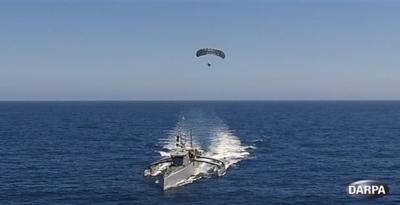Prototype Low-Cost, Elevated Sensor Mast Carrying ISR Payload Greatly Extends Radar, Sensor, And Radio Ranges At Modest Altitude
DARPA’s Anti-Submarine Warfare (ASW) Continuous Trail Unmanned Vessel (ACTUV) program has developed and built a technology demonstration vessel that is currently undergoing open-water testing off the coast of California and recently set sail with its first payload: a prototype of a low-cost, elevated sensor mast developed through the Agency’s Towed Airborne Lift of Naval Systems (TALONS) research effort.

ACTUV seeks to lay the technical foundation for an entirely new class of ocean-going vessel—one able to traverse thousands of kilometers over the open seas for months at a time, without a single crew member aboard. Potential missions include submarine tracking and countermine activities. Towed behind boats or ships, TALONS could persistently carry intelligence, surveillance, reconnaissance (ISR), and communications payloads of up to 150 pounds between 500 and 1,500 feet in altitude—many times higher than current ships’ masts—and greatly extend the equipment’s range and effectiveness.
The demonstration took place over two days with 90 minutes of flight each day. The TALONS prototype started out from its “nest” installed on the back of the ACTUV vehicle. It then expanded its parachute and rose to an altitude of 1,000 feet, where it tested its onboard sensors and communications equipment. Once the test was complete, the prototype reeled itself in back to the nest. The entire process took place as the ACTUV vehicle maneuvered at operationally realistic speeds.
While aloft, TALONS demonstrated significant improvements to the range of the sensors and radios it carried compared to mounting them directly on a surface vessel. For example, TALONS’ surface-track radar extended its range by 500 percent—six times—compared to its range at sea level. Its electro-optical/infrared scanner doubled its observed discrimination range. The TALONS team plugged in a commercial handheld omnidirectional radio; that radio’s range more than tripled.
“I was delighted to explore the possibility of hosting TALONS on ACTUV and from my perspective, the testing could not have gone better,” said Scott Littlefield, DARPA program manager for ACTUV. “We just started at-sea testing of ACTUV in June, and until now we've been focused on getting the basic ship systems to work. TALONS was our first chance to demonstrate hosting a real payload and showing the versatility of ACTUV to do a wide variety of missions for which it wasn't originally designed.”
“TALONS showed the advantages of using a low-cost add-on elevated sensor to extend the vision and connectivity of a surface asset and ACTUV demonstrated its ability as a flexible and robust payload truck,” said Dan Patt, DARPA program manager for TALONS. “This demonstration was an important milestone in showing how clever use of unmanned systems could cost-effectively provide improved capabilities.”
Both Patt and Littlefield commended the teams collaborating on the demonstration for accomplishing the testing in a remarkably short period of time: less than 90 days from the go-ahead decision to the actual demonstration. The team members including Maritime Applied Physics Corporation and the Naval Surface Warfare Center Carderock Division (NSWCC) for TALONS, and the U.S. Navy Space and Naval Warfare Systems Command-Pacific (SSC-PAC) and Leidos for ACTUV.
“This ACTUV/TALONS demonstration is the latest in DARPA’s history of cross-program collaboration to develop breakthrough technologies for national security,” said Brad Tousley, director of DARPA’s Tactical Technology Office (TTO), which oversees both ACTUV and TALONS. “Where it’s a good fit, joint testing provides the opportunity to show the robustness and interoperability of each program’s research, as well to explore potential future uses that wouldn’t be evident by testing each program separately.”
TALONS is part of DARPA’s Phase 1 research for Tern, a joint program between DARPA and the U.S. Navy’s Office of Naval Research (ONR). Now that at-sea demonstration is complete, DARPA is transitioning TALONS to the Navy.
In September 2014, DARPA signed a Memorandum of Agreement (MOA) with ONR to jointly fund an extended test phase of an ACTUV prototype. In April 2016, a christening ceremony in Portland, Oregon, marked the vessel’s formal transition from a DARPA-led design and construction project to open-water testing conducted jointly with ONR. DARPA will collaborate with ONR to fully test the capabilities of the vessel and several innovative payloads over the next two years. Pending the results of those tests, the program could transition to the Navy by 2018.
(Image provided with DARPA news release.)
 ANN's Daily Aero-Term (04.24.24): Runway Lead-in Light System
ANN's Daily Aero-Term (04.24.24): Runway Lead-in Light System ANN's Daily Aero-Linx (04.24.24)
ANN's Daily Aero-Linx (04.24.24) Aero-FAQ: Dave Juwel's Aviation Marketing Stories -- ITBOA BNITBOB
Aero-FAQ: Dave Juwel's Aviation Marketing Stories -- ITBOA BNITBOB Classic Aero-TV: Best Seat in The House -- 'Inside' The AeroShell Aerobatic Team
Classic Aero-TV: Best Seat in The House -- 'Inside' The AeroShell Aerobatic Team Airborne Affordable Flyers 04.18.24: CarbonCub UL, Fisher, Affordable Flyer Expo
Airborne Affordable Flyers 04.18.24: CarbonCub UL, Fisher, Affordable Flyer Expo



